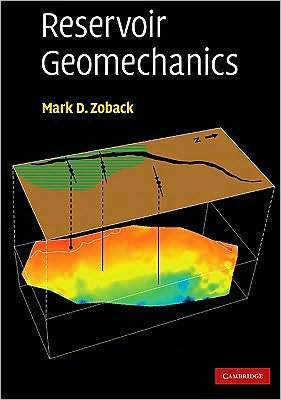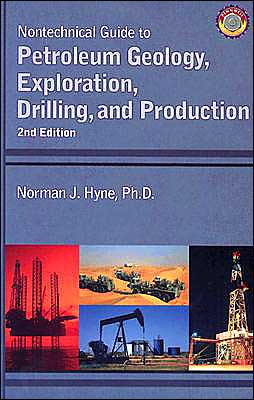Reservoir Geomechanics
This interdisciplinary book encompasses the fields of rock mechanics, structural geology and petroleum engineering to address a wide range of geomechanical problems that arise during the exploitation of oil and gas reservoirs. It considers key practical issues such as prediction of pore pressure, estimation of hydrocarbon column heights and fault seal potential, determination of optimally stable well trajectories, casing set points and mud weights, changes in reservoir performance during...
Search in google:
A practical reference for geoscientists and engineers in the petroleum and geothermal industries.
\ Cambridge University Press\ 9780521770699 - Reservoir Geomechanics - by Mark D. Zoback\ Excerpt\ \ \ \ \ 1 The tectonic stress field\ \ \ My goals in writing this book are to establish basic principles, introduce practical experimental techniques and present illustrative examples of how the development of a comprehensive geomechanical model of a reservoir (and overlaying formations) provides a basis for addressing a wide range of problems that are encountered during the life-cycle of a hydrocarbon reservoir. These include questions that arise (i) during the exploration and assessment phase of reservoir development such as the prediction of pore pressure, hydrocarbon column heights and fault seal (or leakage) potential; (ⅱ) during the development phase where engineers seek to optimize wellbore stability through determination of optimal well trajectories, casing set points and mud weights and geologists attempt to predict permeability anisotropy in fractured reservoirs; (iii) throughout the production phase of the reservoir that requires selection of optimal completion methodologies, the prediction of changes in reservoir performance during depletion and assessment of techniques, such as repeated hydraulic fracturing, to optimize total recovery; and (ⅳ) during the secondary and tertiary recovery phases of reservoir development by optimizing processes such as water flooding and steam injection. Chapters 1– 5 address basic principles related to the components of acomprehensive geomechanical model: the state of stress and pore pressure at depth, the constitutive laws that commonly describe rock deformation and fractures and faults in the formations of interest. Chapters 6– 9 address wellbore failure and techniques for using observations of failure to constrain stress orientation and magnitude in wells of any orientation. Chapters 10– 12 address case studies that apply the principles of the previous chapters to problems of wellbore stability, flow associated with fractures and faults and the effects of depletion on a reservoir and the surrounding formations.\ Why stress is important\ \ The key component of a comprehensive geomechanical model is knowledge of the current state of stress. Wellbore failure occurs because the stress concentrated around the circumference of a well exceeds the strength of a rock (Chapters 6 and 10). A fault will slip when the ratio of shear to effective normal stress resolved on the fault exceeds its frictional strength (Chapters 4, 11 and 12). Depletion causes changes in the stress state of the reservoir that can be beneficial, or detrimental, to production in a number of ways (Chapter 12). As emphasized throughout this book, determination of the state of stress at depth in oil and gas fields is a tractable problem that can be addressed with data that are routinely obtained (or are straightforwardly obtainable) when wells are drilled.\ In this chapter, I start with the basic definition of a stress tensor and the physical meaning of principal stresses. These concepts are important to establish a common vocabulary among readers with diverse backgrounds and are essential for understanding how stress fields change around wellbores (Chapters 6 and 8) and in the vicinity of complex structures such as salt domes (as discussed at the end of the chapter). I also introduce a number of fundamental principles about the tectonic stress field at a regional scale in this chapter. These principles are revisited at scales ranging from individual wellbores to lithospheric plates in Chapter 9. While many of these principles were established with data from regions not associated with oil and gas development, they have proven to have broad relevance to problems encountered in the petroleum industry. For example, issues related to global and regional stress patterns are quite useful when working in areas with little pre-existing well control or when attempting to extrapolate knowledge of stress orientation and relative stress magnitudes from one area to another.\ Stress in the earth’s crust\ Compressive stress exists everywhere at depth in the earth. Stress magnitudes depend on depth, pore pressure and active geologic processes that act at a variety of different spatial and temporal scales. There are three fundamental characteristics about the stress field that are of first-order importance throughout this book:\ Knowledge of stress at depth is of fundamental importance for addressing a wide range of practical problems in geomechanics within oil, gas and geothermal reservoirs and in the overlaying formations.\ The in situ stress field at depth is remarkably coherent over a variety of scales. These scales become self-evident as data from various sources are analyzed and synthesized.\ It is relatively straightforward to measure, estimate or constrain stress magnitudes at depth using techniques that are practical to implement in oil, gas and geothermal reservoirs. Hence, the state of stress is directly determinable using techniques that will be discussed in the chapters that follow.\ In short, the in situ stress field in practice is determinable, comprehensible and needed to address a wide range of problems in reservoir geomechanics.\ \ In this chapter I review a number of key points about the state of stress in the upper part of the earth’s crust. First, we establish the mathematical terminology that will be used throughout this book and some of the fundamental physical concepts and definitions that make it possible to address many practical problems in subsequent chapters. While there are many excellent texts on elasticity and continuum mechanics that discuss stress at great length, it is useful to set forth a few basics and establish a consistent nomenclature for use throughout this book. Next, the relative magnitudes of in situ stresses are discussed in terms of E. M. Anderson’s simple, but powerful, classification scheme (Anderson 1951) based on the style of faulting that would be induced by a given stress state. This scheme leads naturally to some general constraints on stress magnitudes as a function of depth and pore pressure. These constraints will be revisited and refined, first in Chapter 4 where we will discuss constraints on stress magnitudes in terms of the strength of the crust and further refined when we incorporate information about the presence (or absence) of wellbore failures (Chapters 7 and 8).\ In the next section of this chapter I briefly review some of the stress indicators that will be discussed at length in subsequent chapters. I do so in order to review synoptically some general principles about the state of stress in the crust that can be derived from compilations of stress information at a variety of scales. The overall coherence of the stress field, even in areas of active tectonic deformation and geologic complexity is now a demonstrable fact, based on thousands of observations from sites around the world (in a wide range of geologic settings). We next briefly review several mechanisms that control crustal stress at regional scale. Finally, we consider the localized rotation of stress in the presence of near frictionless interfaces, such as salt bodies in sedimentary basins such as the Gulf of Mexico.\ Basic definitions\ In simplest terms, stress is defined as a force acting over a given area. To conform with common practice in the oil and gas industry around the world I utilize throughout the book calculations and field examples using both English units (psi) and SI units (megapascals (MPa), where 1 MPa = 145 psi).\ To be more precise, stress is a tensor which describes the density of forces acting on all surfaces passing through a given point. In terms of continuum mechanics, the stresses acting on a homogeneous, isotropic body at depth are describable as a second-rank tensor, with nine components (Figure 1.1 left).\ \ \ Image not available in HTML version\ \ \ The subscripts of the individual stress components refer to the direction that a given force is acting and the face of the unit cube upon which the stress component acts. Thus, any given stress component represents a force acting in a specific direction on a unit area of given orientation. As illustrated in the left side of Figure 1.1, a stress tensor can be defined in terms of any reference system. An arbitrarily oriented cartesian coordinate system is shown. Because of equilibrium conditions\ \ \ Image not available in HTML version\ \ \ so that the order of the subscripts is unimportant. In general, to fully describe the state of stress at depth, one must define six stress magnitudes or three stress magnitudes and the three angles that define the orientation of the stress coordinate system with respect to a reference coordinate system (such as geographic coordinates, wellbore coordinates, etc.).\ \ \ Image not available in HTML version\ \ \ Figure 1.1 Definition of stress tensor in an arbitrary cartesian coordinate system (Engelder and Leftwich 1997), rotation of stress coordinate systems through tensor transformation (center) and principal stresses as defined in a coordinate system in which shear stresses vanish (right).\ In keeping with the majority of workers in rock mechanics, tectonophysics and structural geology, I utilize the convention that compressive stress is positive because in situ stresses at depths greater than a few tens of meters in the earth are always compressive. Tensile stresses do not exist at depth in the earth for two fundamental reasons. First, because the tensile strength of rock is generally quite low (see Chapter 4), significant tensile stress cannot be supported in the earth. Second, because there is always a fluid phase saturating the pore space of rock at depth (except at depths shallower than the water table), the pore pressure resulting from this fluid phase would cause the rock to hydraulically fracture should the least compressive stress reach a value close to the value of the pore pressure (Chapter 4).\ Once a stress tensor is known in one coordinate system, it is possible to evaluate stresses in any other coordinate system via tensor transformation. To accomplish this transformation, we need to specify the direction cosines (, as illustrated in Figure 1.1) that describe the rotation of the coordinate axes between the old and new coordinate systems. Mathematically, the equation which accomplishes this is\ \ \ Image not available in HTML version\ \ \ where,\ \ \ Image not available in HTML version\ \ \ There are two reasons why the ability to transform coordinate systems is of fundamental importance here. First, once we know an in situ stress field in some coordinate system, we can compute stresses in any other. For example, if we know the stress state in a geographic coordinate system, we will show how it is possible to derive the stress field surrounding a wellbore of arbitrary orientation (Chapter 8) to address problems of stability (Chapter 10), or along a fault plane (Chapter 5) to gauge its proximity to frictional failure and slip (Chapter 11). Another reason why tensor transformation is important is because we can choose to describe the state of stress at depth in terms of the principal stresses (i.e. those acting in the principal coordinate system), making the issue of describing the stress state in situ appreciably easier. The principal coordinate system is the one in which shear stresses vanish and three principal stresses, _ fully describe the stress field (as illustrated in the right side of Figure 1.1). In the principal coordinate system we have diagonalized the stress tensor such that the principal stresses correspond to the eigenvalues of the stress tensor and the principal stress directions correspond to its eigenvectors:\ \ \ Image not available in HTML version\ \ \ The reason this concept is so important is that because the earth’s surface is in contact with a fluid (either air or water) which cannot support shear tractions, it is a principal stress plane. Thus, one principal stress is generally normal to the earth’s surface with the other two principal stresses acting in an approximately horizontal plane. While it is clear that this must be true close to the earth’s surface, compilation of earthquake focal mechanism data and other stress indicators (described below) suggest that it is also generally true to the depth of the brittle–ductile transition in the upper crust at about 15–20 km depth (Zoback and Zoback 1980, 1989; Zoback 1992). Assuming this is the case, we must define only four parameters to fully describe the state of stress at depth: three principal stress magnitudes, Sv, the vertical stress, corresponding to the weight of the overburden; SHmax, the maximum principal horizontal stress; and Shmin, the minimum principal horizontal stress and one stress orientation, usually taken to be the azimuth of the maximum horizontal compression, SHmax. This obviously helps make stress determination in the crust (as well as description of the in situ stress tensor) a much more tractable problem than it might first appear.\ \ Relative stress magnitudes and E. M. Anderson’s classification scheme\ \ \ \ In applying these concepts to the earth’s crust, it is helpful to consider the magnitudes of the greatest, intermediate, and least principal stress at depth (S1, S2, and S3) in terms of Sv, SHmax and Shmin in the manner originally proposed by E. M. Anderson and alluded to above. As illustrated in Figure 1.1 and Table 1.1, the Anderson scheme classifies an area as being characterized by normal, strike-slip or reverse faulting depending on whether (i) the crust is extending and steeply dipping normal faults accommodate movement of the hanging wall (the block of rock above the fault) downward with respect to the footwall (the block below the fault), (ⅱ) blocks of crust are sliding horizontally past one another along nearly vertical strike-slip faults or (iii) the crust is in compression and relatively shallow-dipping reverse faults are associated with the hanging wall block moving upward with respect to the footwall block. The Anderson classification scheme also defines the horizontal principal stress magnitudes with respect to the vertical stress. The vertical stress, Sv, is the maximum principal stress (S1) in normal faulting regimes, the intermediate principal stress (S2) in strike-slip regimes and the least principal stress (S3) in reverse faulting regimes. The dip and strike of expected normal, strike-slip and reverse faults with respect to the principal stress are discussed in Chapter 4.\ Relative stress magnitudes and faulting regimes\ \ \ \ \ \ \ \ Stress\ \ \ \ \ \ \ Regime\ \ \ \ S1\ S2\ S3\ \ \ Normal\ Sv\ SHmax\ Shmin\ \ \ Strike-slip\ SHmax\ Sv\ Shmin\ \ \ Reverse\ SHmax\ Shmin\ Sv\ \ \ \ \ \ \ \ \ \ \ Image not available in HTML version\ \ \ Figure1.2 E. M. Anderson’s classification scheme for relative stress magnitudes in normal, strike-slip and reverse faulting regions. Earthquake focal mechanisms, the beach balls on the right, are explained in Chapter .\ The magnitude of 5Sv is equivalent to integration of rock densities from the surface to the depth of interest, z. In other words,\ \ \ \ \ \ Image not available in HTML version\ \ \ where ρ(z) is the density as a function of depth, g is gravitational acceleration and is the mean overburden density (Jaeger and Cook 1971). In offshore areas, we correct for water depth\ here ρw is the density of water and zw is the water depth. As ρw ∼ 1 g/cm3 (1.0 SG), water pressure (hydrostatic pressure) increases at a rate of 10 MPa/km (0.44 psi/ft). Most clastic sedimentary rock has an average density of about 2.3 g/cm3 which corresponds to a porosity of about 15%. This results in a vertical principal stress that increases with depth at a rate of 23 MPa/km (or conveniently, ∼1 psi/ft). Correspondingly, the magnitudes of the two horizontal principal stresses increase with depth. Some of the practical problems associated with the computation of Sv using equations () and () relate to the facts that density logs frequently measure anomalously low density when the well is rugose and density is often not measured all the way up to the seafloor when drilling offshore. This is illustrated by the density log in Figure 1.3. The density log (top figure) is somewhat noisy and no data are available between the seafloor (1000 ft below the platform) and 3600 ft. This makes it necessary to extrapolate densities to the seafloor where the density is quite low. Integration of the density log using equation () yields the overburden stress as a function of depth (middle figure). The rate at which the overburden stress gradient increases with depth is shown in the lower figure. Note that because of the water depth and low densities immediately below the seafloor (or mud line), the overburden stress gradient is only 0.9 psi/ft at a depth of 14,000 ft, even though density exceeds 2.3 g/cm3 below 8000 ft.\ According to the Anderson classification scheme, the horizontal principal stresses may be less than, or greater than, the vertical stress, depending on the geological setting. The relative magnitudes of the principal stresses are simply related to the faulting style currently active in a region. As illustrated in Figure 1.2, the vertical stress dominates in normal faulting regions (S1 = Sv), and fault slip occurs when the least horizontal principal stress (Shmin) reaches a sufficiently low value at any given depth depending on Sv and pore pressure (Chapter 4). Conversely, when both horizontal stresses exceed the vertical stress (S3 = Sv) crustal shortening is accommodated through reverse faulting when the maximum horizontal principal stress (SHmax) is sufficiently larger than the vertical stress. Strike-slip faulting represents an intermediate stress state (S2 = Sv), where the maximum horizontal stress is greater than the vertical stress and the minimum horizontal stress is less (SHmax ≥ Sv ≥ Shmin). In this case, faulting occurs when the difference between SHmax and Shmin is sufficiently large. The angle between the principal stress directions and the strike and dip of active faults is discussed in Chapter 5.\ Third, an implicit aspect of Andersonian faulting theory is that the magnitudes of the three principal stresses at any depth are limited by the strength of the crust at depth. An obvious upper limit for stress magnitudes might be the compressive strength of rock. In fact, a more realistic upper limit for the magnitudes of principal stresses in situ is the frictional strength of previously faulted rock, as essentially all rocks at depth contain pre-existing fractures and faults (Chapter 4).\ Of critical interest in this book is the current state of stress (or perhaps that which existed at the onset of reservoir exploitation) because that is the stress state applicable in the problems of reservoir geomechanics considered in this book. Hence, a point about Figure 1.2 worth emphasizing is that the figure shows the relationship between states of stress and the style of faulting consistent with that stress state. In some parts of the world\ \ \ \ \ \ Image not available in HTML version\ \ \ Figure1.3 Illustration of how integration of density logs (upper figure) can be used to estimate overburden stress at depth (center figure) or overburden stress gradient (lower figure). Variability of the density logs, as well as the fact that they are often not obtained over the total depth of interest, leads to uncertainty in the calculated overburden (see text).\ there is a close correspondence between the current stress field and large-scale active faults in the region. Western California (discussed below) is such a region. However, in other regions, the current stress state is not consistent with large-scale geologic structures because those structures evolved during previous tectonic regimes, in some cases, regimes that have not been active for tens, or even hundreds, of millions of years. In fact, in some parts of the world there is a marked disagreement between currently active tectonic stresses and the large-scale geologic structures defining oil and gas. One example of this is the Tampen Spur area of the northern North Sea (mentioned below and discussed in detail in Chapter 9) where earthquake focal mechanisms and direct stress measurements indicate that there is currently a compressional (strike-slip and reverse faulting) state of stress in much of the area, but the principal geologic structures are those associated with extension and basin formation (normal faulting and subsidence) at the time of opening of the North Atlantic in Cretaceous time, more than 70 million years ago. As discussed in Chapter 9, the compressional stresses in this area appear to arise from lithospheric flexure associated with deglaciation and uplift of Fennoscandia in only the past 20,000 years. In some places in the northern North Sea, after tens of millions of years of fault dormancy, some of the normal faults in the region are being reactivated today as strike-slip and reverse faults in the highly compressional stress field (Wiprut and Zoback 2000). The opposite is true of the eastern foothills of the Andes in Colombia and the Monagas basin of eastern Venezuela. Although extremely high horizontal compression and reverse faulting were responsible for formation of the large-scale reverse faults of the region, the current stress regime is much less compressive (strike-slip to normal faulting) (Colmenares and Zoback 2003).\ \ \ \ © Cambridge University Press
Preface xiPart I Basic Principles1 The tectonic stress field 3Why stress is important 3Stress in the earth's crust 4Basic definitions 5Relative stress magnitudes and E.M. Anderson's classification scheme 8Stress magnitudes at depth 12Measuring in situ stress 14Indicators of contemporary stress orientation and relative magnitude 16Regional stress patterns 18Frictionless interfaces 242 Pore pressure at depth in sedimentary basins 27Basic definitions 27Reservoir compartmentalization 29Mechanisms of overpressure generation 40Estimating pore pressure at depth 443 Basic constitutive laws 56Linear elasticity 61Elastic moduli and seismic wave velocity 63Elasticity anisotropy 65Poroelasticity and effective stress 65Poroelasticity and dispersion 69Viscous deformation in uncemented sands 72Thermoporoelasticity 834 Rock failure in compression, tension and shear 84Rock strength in compression 87Compressive strength criteria 92Strength and pore pressure 104Rock strength anisotropy 105Estimating rock strength from geophysical log data 107Shear-enhanced compaction 118Tensile rock failure 121Shear failure and the frictional strength of rocks 123The critically stressed crust 127Limits on in situ stress from the frictional strength of faults 130Stress polygon 1375 Faults and fractures at depth 140Faults, fractures and fluid flow 142Wellbore imaging 146Representation of fracture and fault data at depth 149Three-dimensional Mohr diagrams 154Earthquake focal mechanisms 158Part II Measuring Stress Orientation and Magnitude6 Compressive and tensile failures in vertical wells167Stress concentration around a cylindrical hole and wellbore failure 169Quality ranking system for stress indicators 187More on drilling-induced tensile fractures 190More on wellbore breakouts 1967 Determination of S3 from mini-fracs and extended leak-off tests and constraining the magnitude of SHmax from wellbore failure in vertical wells 206Hydraulic fracturing to determine S3 208Can hydraulic fracturing be used to estimate the magnitude of SHmax? 220Wellbore failure and the determination of SHmax 222Drilling-induced tensile fractures and the magnitude of SHmax 228Estimating rock strength from breakouts when tensile fractures are present 231Estimating SHmax from breakout rotations 231Summary 2338 Wellbore failure and stress determination in deviated wells 235State of stress surrounding an arbitrarily deviated well 236Failure of arbitrarily deviated wells 239Confirming that SHmax and Shmin are principal stresses 246Estimating SHmax from breakouts and tensile fractures in deviated wells 247Distinguishing drilling-induced tensile fractures from natural fractures 252Determination of SHmax orientation from shear velocity anisotropy in deviated wells 2559 Stress fields - from tectonic plates to reservoirs around the world 266Global stress patterns 266Sources of crustal stress 270Normal faulting stress fields in sedimentary basins 273Methods for approximating Shmin in normal faulting areas 281Compressional stress states in sedimentary basins 287A few more comments about the bilateral constraint 292Interpolation and extrapolation of stress magnitude data 294Part III Applications10 Wellbore stability 301Preventing wellbore instability during drilling 303Quantitative risk assessment 312Role of rock strength anisotropy 317Mud/rock interaction 321Maximizing the frac gradient 322Mud penetration and time-dependent wellbore failure 330Preventing sand production 33111 Critically stressed faults and fluid flow 340Fractured reservoirs and permeability anisotropy 341Some representative case studies 349Identification of critically stressed faults and breakout rotations 358Intentionally induced microseismicity to enhance permeability 360Fault seal/blown trap 362Dynamic constraints on hydrocarbon migration 36912 Effects of reservoir depletion 378Stress changes in depleting reservoirs 380Deformation in depleting reservoirs 397Deformation and stress changes outside of depleting reservoirs 412References 423Index 445
\ From the Publisher'A very comprehensive and complete book spanning all the aspects of stress within the accessible Earth. It is particularly useful in the fields of oil industry, geothermics and seismic hazard.' Tectonophysics\ '… a strong and authoritative treatment … Professor Zoback's book will be a valued guide and reference to geoscientists and engineers.' International Journal of Rock Mechanics and Mining Sciences\ 'A major advantage of the book is … that it provides an excellent crossover between aspects of structural geology and reservoir engineering - a link that is all too often overlooked. … It is customary to have an 'ah but …', bit towards the end, but I genuinely have very few quibbles with this book. … I would recommend it to any geologist working in a situation where faults or fractures interact with the present-day stress field.' Tim Needham, Needham Geoscience, Illkley\ \ \








